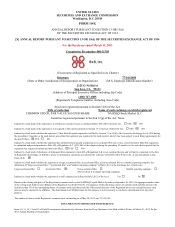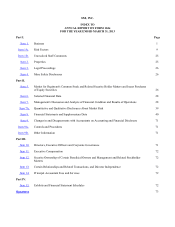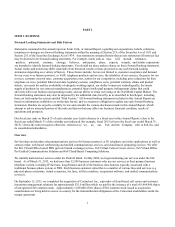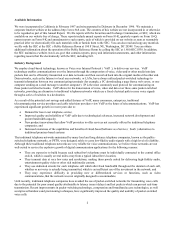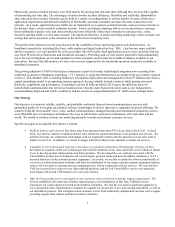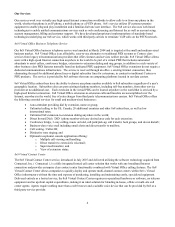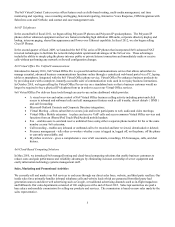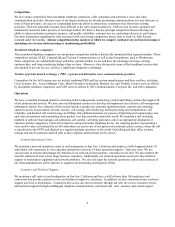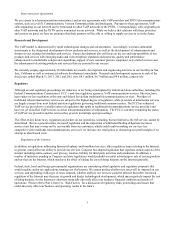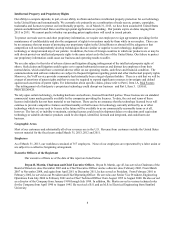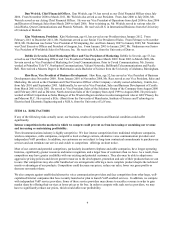8x8 2013 Annual Report Download - page 4
Download and view the complete annual report
Please find page 4 of the 2013 8x8 annual report below. You can navigate through the pages in the report by either clicking on the pages listed below, or by using the keyword search tool below to find specific information within the annual report.2
Available Information
We were incorporated in California in February 1987 and reincorporated in Delaware in December 1996. We maintain a
corporate Internet website at the address http://www.8x8.com. The contents of this website are not incorporated in or otherwise
to be regarded as part of this Annual Report. We file reports with the Securities and Exchange Commission, or SEC, which are
available on our website free of charge. These reports include annual reports on Form 10-K, quarterly reports on Form 10-Q,
current reports on Form 8-K and amendments to such reports, each of which is provided on our website as soon as reasonably
practical after we electronically file such materials with or furnish them to the SEC. You can also read and copy any materials
we file with the SEC at the SEC’s Public Reference Room at 100 F Street, NE, Washington, DC 20549. You can obtain
additional information about the operation of the Public Reference Room by calling the SEC at 1.800.SEC.0330. In addition,
the SEC maintains a website (www.sec.gov) that contains reports, proxy and information statements, and other information
regarding issuers that file electronically with the SEC, including 8x8.
Industry Background
We employ cloud-based technology, known as Voice over Internet Protocol (“VoIP”), to deliver our services. VoIP
technology enables communications over the Internet through the compression of voice, video and/or other media into data
packets that can be efficiently transmitted over data networks and then converted back into the original media at the other end.
Data networks, such as the Internet or local area networks, or LANs, have always utilized packet-switched technology to
transmit information between two communicating terminals (for example, a PC downloading a page from a web server, or one
computer sending an e-mail message to another computer). IP is the most commonly used protocol for communicating on
these packet switched networks. VoIP allows for the transmission of voice, video and data over these same packet-switched
networks, providing an alternative to traditional telephone networks which use a fixed electrical path to carry voice signals
through a series of switches to a destination.
As a result of the potential cost savings and added features of VoIP, many consumers, enterprises, traditional
telecommunication service providers and cable television providers view VoIP as the future of telecommunications. VoIP has
experienced significant growth in recent years due to:
Demand for lower cost telephone service;
Improved quality and reliability of VoIP calls due to technological advances, increased network development and
greater bandwidth capacity;
New product innovations that allow VoIP providers to offer services not currently offered by traditional telephone
companies; and
Increased awareness of the capabilities and benefits of cloud-based Software as a Service (“SaaS”) alternatives to
traditional premises-based systems
The traditional telephone networks maintained by many local and long distance telephone companies, known as the public-
switched telephone networks, or PSTN, were designed solely to carry low-fidelity audio signals with a high level of reliability.
Although these traditional telephone networks are very reliable for voice communications, we believe these networks are not
well-suited to service the explosive growth of digital communication applications for the following reasons:
They are expensive to build because each subscriber's telephone must be individually connected to the central office
switch, which is usually several miles away from a typical subscriber's location;
They transmit data at very low rates and resolutions, making them poorly suited for delivering high-fidelity audio,
entertainment-quality video or other rich multimedia content;
They use dedicated circuits for each telephone call which allot fixed bandwidth throughout the duration of each call,
whether or not voice is actually being transmitted, which is an inefficient use of the investment in the network; and
They may experience difficulty in providing new or differentiated services or functions, such as video
communications, that the network was not originally designed to accommodate.
Until recently, traditional telephone companies have avoided the use of packet-switched networks for transmitting voice calls
due to the potential for poor sound quality attributable to latency issues (delays) and lost packets which can prevent real-time
transmission. Recent improvements in packet-switching technology, compression and broadband access technologies, as well
as improved hardware and provisioning techniques, have significantly improved the quality and usability of packet-switched
voice calls.

